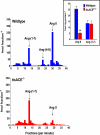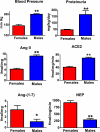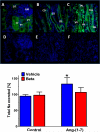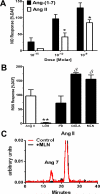Nonclassical renin-angiotensin system and renal function
- PMID: 23720263
- PMCID: PMC4186703
- DOI: 10.1002/cphy.c120002
Nonclassical renin-angiotensin system and renal function
Abstract
The renin-angiotensin system (RAS) constitutes one of the most important hormonal systems in the physiological regulation of blood pressure through renal and nonrenal mechanisms. Indeed, dysregulation of the RAS is considered a major factor in the development of cardiovascular pathologies, including kidney injury, and blockade of this system by the inhibition of angiotensin converting enzyme (ACE) or blockade of the angiotensin type 1 receptor (AT1R) by selective antagonists constitutes an effective therapeutic regimen. It is now apparent with the identification of multiple components of the RAS within the kidney and other tissues that the system is actually composed of different angiotensin peptides with diverse biological actions mediated by distinct receptor subtypes. The classic RAS can be defined as the ACE-Ang II-AT1R axis that promotes vasoconstriction, water intake, sodium retention, and other mechanisms to maintain blood pressure, as well as increase oxidative stress, fibrosis, cellular growth, and inflammation in pathological conditions. In contrast, the nonclassical RAS composed primarily of the AngII/Ang III-AT2R pathway and the ACE2-Ang-(1-7)-AT7R axis generally opposes the actions of a stimulated Ang II-AT1R axis through an increase in nitric oxide and prostaglandins and mediates vasodilation, natriuresis, diuresis, and reduced oxidative stress. Moreover, increasing evidence suggests that these non-classical RAS components contribute to the therapeutic blockade of the classical system to reduce blood pressure and attenuate various indices of renal injury, as well as contribute to normal renal function.
© 2012 American Physiological Society
Figures









Similar articles
-
Biochemical evaluation of the renin-angiotensin system: the good, bad, and absolute?Am J Physiol Heart Circ Physiol. 2016 Jan 15;310(2):H137-52. doi: 10.1152/ajpheart.00618.2015. Epub 2015 Oct 16. Am J Physiol Heart Circ Physiol. 2016. PMID: 26475588 Free PMC article. Review.
-
Update on the Angiotensin converting enzyme 2-Angiotensin (1-7)-MAS receptor axis: fetal programing, sex differences, and intracellular pathways.Front Endocrinol (Lausanne). 2014 Jan 9;4:201. doi: 10.3389/fendo.2013.00201. Front Endocrinol (Lausanne). 2014. PMID: 24409169 Free PMC article. Review.
-
Novel roles of nuclear angiotensin receptors and signaling mechanisms.Am J Physiol Regul Integr Comp Physiol. 2012 Mar 1;302(5):R518-30. doi: 10.1152/ajpregu.00525.2011. Epub 2011 Dec 14. Am J Physiol Regul Integr Comp Physiol. 2012. PMID: 22170620 Free PMC article. Review.
-
ACE2 and vasoactive peptides: novel players in cardiovascular/renal remodeling and hypertension.Ther Adv Cardiovasc Dis. 2015 Aug;9(4):217-37. doi: 10.1177/1753944715597623. Epub 2015 Aug 13. Ther Adv Cardiovasc Dis. 2015. PMID: 26275770 Review.
-
The vasoprotective axes of the renin-angiotensin system: Physiological relevance and therapeutic implications in cardiovascular, hypertensive and kidney diseases.Pharmacol Res. 2017 Nov;125(Pt A):21-38. doi: 10.1016/j.phrs.2017.06.005. Epub 2017 Jun 12. Pharmacol Res. 2017. PMID: 28619367 Free PMC article. Review.
Cited by
-
Renal Denervation Influences Angiotensin II Types 1 and 2 Receptors.Int J Nephrol. 2022 Oct 10;2022:8731357. doi: 10.1155/2022/8731357. eCollection 2022. Int J Nephrol. 2022. PMID: 36262553 Free PMC article. Review.
-
Intracellular angiotensin (1-7) increases the inward calcium current in cardiomyocytes. On the role of PKA activation.Mol Cell Biochem. 2015 Sep;407(1-2):9-16. doi: 10.1007/s11010-015-2449-4. Epub 2015 May 16. Mol Cell Biochem. 2015. PMID: 25981535
-
ACE2 alterations in kidney disease.Nephrol Dial Transplant. 2013 Nov;28(11):2687-97. doi: 10.1093/ndt/gft320. Epub 2013 Aug 16. Nephrol Dial Transplant. 2013. PMID: 23956234 Free PMC article. Review.
-
Mechanisms of AT1a receptor-mediated uptake of angiotensin II by proximal tubule cells: a novel role of the multiligand endocytic receptor megalin.Am J Physiol Renal Physiol. 2014 Jul 15;307(2):F222-33. doi: 10.1152/ajprenal.00693.2013. Epub 2014 Apr 16. Am J Physiol Renal Physiol. 2014. PMID: 24740791 Free PMC article.
-
Angiotensin-(1-7)-dependent vasorelaxation of the renal artery exhibits unique angiotensin and bradykinin receptor selectivity.Peptides. 2017 Apr;90:10-16. doi: 10.1016/j.peptides.2017.02.001. Epub 2017 Feb 10. Peptides. 2017. PMID: 28192151 Free PMC article.
References
-
- Abadir PM, Carey RM, Siragy HM. Angiotensin AT2 receptors directly stimulate renal nitric oxide in bradykinin B2-receptor null mice. Hypertension. 2003;42:600–604. - PubMed
-
- Ahmad A, Ward PE. Role of aminopeptidase activity in the regulation of the pressor activity of circulating angiotensins. J Pharmacol Exp Ther. 1990;252:643–650. - PubMed
Publication types
MeSH terms
Substances
Grants and funding
LinkOut - more resources
Full Text Sources
Medical
Miscellaneous

